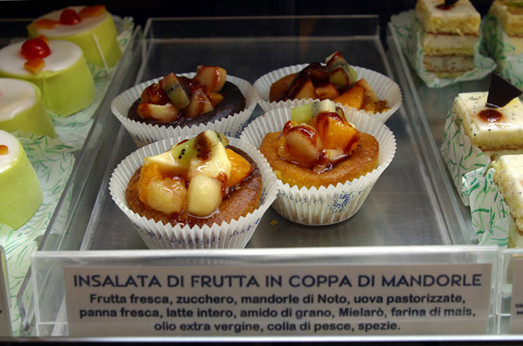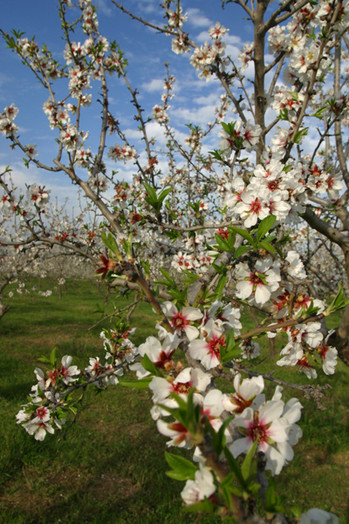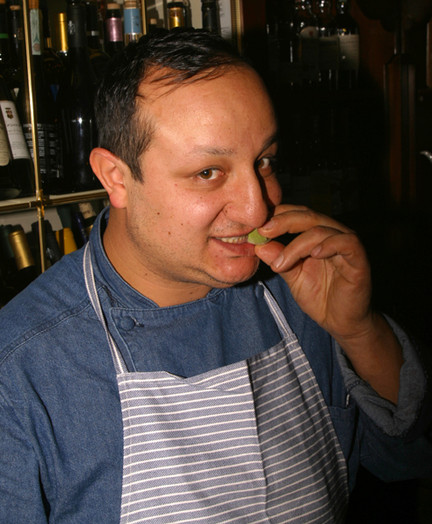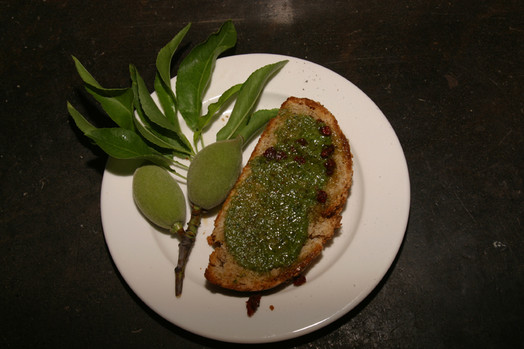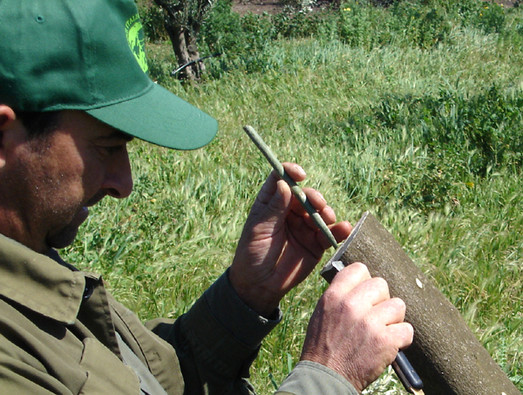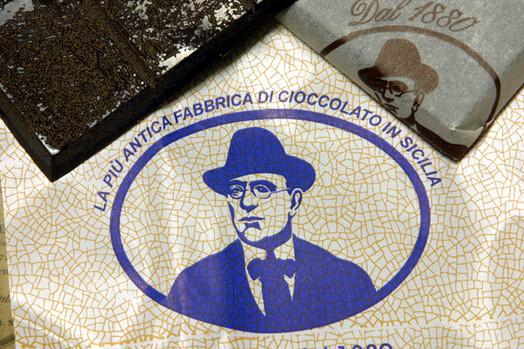Joe Ray
Food & Travel / Words & Photos
Tuesday, March 27, 2007
Stir 1 day, then chill. Or: The Mother of All Ice Cream Sandwiches
When I arrived in Palermo, the first thing I wanted to do was have a gelato or slushy granita in a brioche. I now know the first one I ate to have been junk.
This weekend, however, I struck gold.
At the end of a Sunday walk, I found a crowd spilling out onto the sidewalk from the Gelateria da Carlo near the train station. I pushed my way in and saw the sign: Brioche Calde con Gelato. “Calde” (hot) was underlined three times, which was all the convincing I needed.
Ticket and pre-paid receipt in hand, I waited for my number (78) to be called. I ordered and the guy pulled a brioche from a plastic bag, halved it (moving the brioche, not the knife for some reason) and filled it with hazelnut and almond gelato. He put the whole thing in what looked like a George Foreman Grill, closed it, and let it work its magic for 14 seconds.
It comes out as a sealed unit that looks like a flying saucer, and the first bite gives you the warmth of the brioche, the cold of the ice cream and the little bit that’s just starting to melt from the heat.
Hoo, dear.
On Saturday, in the town of Cinisi, about a half-hour train ride west of Palermo, I met Santi Palazzolo, a master pastry chef, master chocolatier and ice cream fanatic.
“My grandfather didn’t have machines to make ice cream,” he says, referring back to the Palazzolo pastry shop’s founder. “One guy would turn the basin (which sat in an ultra-cold salted slush mix) with his hands while my grandfather would scrape the ice off the inside,” he said, demonstrating what looked like a ridiculously labor-intensive procedure.
We’ve come a long way.
Palazzolo led the way to the shop’s giant basement laboratory, passing through dedicated pastry and chocolate sections, before stopping in a tiny room with what looked like three stainless steel washing machines: a pasteurizer, an emulsifier and a chiller.
Like the setup at the Padova olive oil mill, it ain’t sexy, but the process yields incredible results.
Palazzolo breaks his gelato into two rough categories: gelato without milk, which are the fruit flavors, and gelato with milk - the ‘nut & bean’ flavors (like vanilla, coffee or hazelnut), with the latter group spending up to a whopping 24 hours in the emulsifier before going into the chiller. Mouthfeel fans and the rest of humanity will find this time well spent.
There are a stack of tricks and techniques like this Palazzolo uses to coax the most flavor from his ingredients, some technical like low-temperature pasteurization, others learned.
“We add lemon juice to that gelato just before refrigerating it (as opposed to all other fruit flavors, where the juice is added at the beginning),” he says. “It gets rid of a metallic taste.”
Back in Palermo, after giving my complete attention to my hot brioche with gelato, I watched the world go by.
Carlo’s is not beautiful. It sits in a building made from what looks like fancy cinder blocks and the inside is lit with blue lights. But it’s overflowing with people of all ages, all enjoying their Sunday treat. Two year old Palermitans, whose chocolate-covered faces would be best cleaned with a mop, mill around with goofy grins. Pre-teen girls, with little rolls of fat spilling out between their layers of fake Dolce & Gabbana clothes, mill around in packs. There are also middle-aged couples, workers on a break, grandparents, and teens on scooters.
It’s horns, Vespas, sunglasses when the sun’s not out, cigarettes, litter, strutting and family. It’s a kid wearing two shades of orange clothes and his dad with the same two shades on his cone. It’s a micro fender-bender and the arm flapping, hunched shoulder discussion that follows and the guy who rides by with a cardboard license plate taped to the fender of his scooter.
Today, hot brioche in hand, I got a big scoop of Palermo.
This is Joe Ray reporting from the Motherland.
Friday, March 23, 2007
Making Oil With The Brothers
The day before I left southern Sicily, Francesco and his brother Sal took me to the mill where they turn olives into oil - the perfect going away present for a food geek like me.
Something of an industrialist’s dream and photographer’s nightmare, the huge space is seemingly filled with nothing but stainless steel machines and white tile.
After Sal’s comprehensive tour, I can now say that I have seen the future, and though it’s not as sexy looking as the past, it tastes better.
“The old way of doing it is much more romantic, but the quality sucks,” said Francesco in his characteristic deadpan.
Two keys to the tourist-worthy ‘old way’ meant crushing the olives in an enormous granite-wheeled mill, then spreading the paste between circular woven mats called fiscola and crushing them in a press to yield the unrefined oil.
Compared with the ‘new way’, the granite mill now seems like a big vat to sneeze into while the olives oxidize and the mats look impossible to clean.
“Now, we can clean the whole system with water pressure,” said Francesco, who demonstrated by pretending to shoot a pair of machine guns from the hip.
The ‘new way,’ which producers were reluctantly getting used to when I was researching an olive oil story in 2002, is much different. Once the olives come into the mill, they are cleaned and de-stemmed and pulverized in two ways in a hammering machine called a frangitore a martelli, before being kneaded into a fine paste in stainless steel vats and passed through a pair of centrifuges.
The system is now a closed and temperature-controlled one where nitrogen is used to prevent oxidation. At the mill, they can even process different oils from different producers at the same time and the whole system is run by a computer.
“I can regulate the whole thing from Rome with my Palm Pilot,” said Sal, though I saved asking why for another day.
“The technology is so advanced here,” he said, gesturing toward the centrifuges, “that most experimentation and research concentrates on the hammers and the kneading.”
The goal of both of these processes is to keep the temperature low. Once the temperature goes up, the flavor leeches out.
The frangitore, for example, now crushes the olives two different ways (instead of one), which saves a couple of degrees. The paste is then pumped into the kneading vats which are held between 78.8 and 80.6 degrees. They’ll mix for no more than 30 minutes, as more than that makes the temperature rise.
The vats are also the first stage where nitrogen comes into play, replacing the air above the vats, in an effort not unlike pouring lemon juice over guacamole or a fresh-cut artichoke.
It seems like a lot of fuss, but as they explain it, modifying the system is the only way to increase quality.
We finish up the tour nibbling their almonds and drinking wine, poured from a giant stainless steel vat.
“Olive oil is not a product that can be modified,” said Sal who goes on to explain that you can mess it up, but you can’t really make it better.
“The difference between wine and olive oil is that you can work on wine in the winery. Olive oil is as it is. You just have to be good in the plant when you transform it.”
This is Joe Ray reporting from the Motherland.
Friday, March 23, 2007
The Four Senses of Corrado Assenza
Talk with enough chefs worth their salt and they’ll almost inevitably take a good hunk of time to preach the virtues of the importance of raw materials.
At an unassuming café in the southern Sicilian town of Noto, pastry master Corrado Assenza dwells on such things for about 20 seconds before he launches into the culinary stratosphere on a gastro-philosophical jag that explains both the primacy of the almond and the overall state of Sicilian pastry making.
Leaving two shot glasses of almond milk in front of Francesco and me, Italy’s 2006 pastry chef of the year walks away, returning only when we’ve finished. He then places a jelly jar of almond cream on the table saying, “This is the base. From this, you can make everything.”
It’s pretty much the first thing he’s said and it’s not terribly clear what ‘everything’ means, but he explains.
Mixed with water, almond cream becomes almond milk. Mixed with a bit of marmalade, it’s the perfect center to a delicate brioche.
“These are the bones,” he says, pointing at the jar on the table while grabbing my knobby wrist and shaking it, “We need bones to make this body.”
‘This body’ is Sicilian pastry as a whole and I feel downright flattered to serve as the example.
“We have about 80 products that we make here and about 30 that use almonds and still others where it’s just to give a bit of the taste.”
Despite more than 1,000 years of Sicilian almond history, in both sweet and savory dishes, Assenza is not sitting around just recreating the classics. His prima case a fumo (“before it became smoke”) is layers of what he calls tobacco cream, cocoa beans, almond and marzipan slices, topped with a strawberry cream. He’s also come up with what he calls insalata di frutta in coppa di mandorle (“fruit salad in an almond cup”), a curious and delicious cousin to strawberry shortcake, where the ingredients of the ‘cup’ include almond flour and olive oil (butter’s a rare bird here).
If this is what the future will be like, visitors to Noto should look forward to getting older in Sicily.
“We have too many ways to apply our tradition. We can copy the past, or use our ability to…interpret it with our eyes, mouth and senses,” he says. “I prefer the second way.”
One of Assenzo’s biggest preoccupations is getting this mix of old and new to the people who might understand or appreciate it the least: tourists and the gastronomically uninterested.
“I remember the when travelers used to come through here in the 60s,” he says, calling the set “Byron Travelers” as they might set up camp in Noto for months at a time.
Now, however, people have morphed into what he refers to – without bitterness – as ‘click and run’ tourists.
So do the lucky ones who happen into Caffe Sicilia get what he’s trying to do?
Disturbingly, he dodges the question a bit, but answers with optimism.
“Now, people arrive with their guide books in hand. I say, ‘Please, close your eyes. Use your ears.’ People aren’t unable to use their senses,” he affirms.
“The key is food. Sweet food.”
Along with their sense of hearing, he says he tries to create a connection to Sicily using color, texture and flavor.
He also uses basil ice cream.
It’s disarming stuff that short circuits your senses, leaving you with only goose bumps and a grin as descriptors.
For Assenzo, basil ice cream and a dreamy almond sorbet – both of which have a minimalist’s ingredient list – are tools to reach ‘click and run’ kids from Sicily and abroad.
“They have other kinds of experience, so you should commence with something special,” he explains with Zen gentillesse. “You need to help them arrive with something simple.”
It isn’t as simple as it sounds to get something like this to work.
“We use technology so we don’t damage the taste of the basil leaves,” he explains. “It took one and a half years to come up with something so we could arrive at this.” In Sicily, where man’s relationship with technology is peculiar at best, this guy is an outright visionary.
So, after discussing his raft of offerings and their philosophical and near-spiritual uses, what’s his favorite dessert?
“It’s the next one. It’s the one I haven’t thought of yet.”
In the meantime, he’ll let his creations be ambassadors of the good stuff to locals and tourists alike.
“Each cake,” he concludes, “is part of a tale that brings you into our land.”
This is Joe Ray reporting from the Motherland.
Thursday, March 22, 2007
Don’t knock it…
Day one in Palermo
MENU
Breakfast: Lemon granite (like a slushy sorbet) on a brioche bun
Lunch: Pane ca meusa – a spleen sandwich
Dinner #1: Foot, udder, tongue and head meat - all cow, served cold - sprinkled with salt and doused with lemon, served on the converted back of a three-wheeled Vespa Ape truck. 500 grams (about a pound), 2 euros (about $2.50).
Dinner #2: Food from Ghana. I yelled over the music, asking if they had a soup with vegetables. I got a stew with huge hunks of liver, lung and tripe in a spicy red sauce, with a huge side of rice. All to be eaten with your hands. It was great. Special note: when a bit of a scuffle broke out by the register, this restaurant also won the prize for the first one where I’ve ever looked for a back door.
Dessert: two Moretti beers while I type.
This is Joe Ray reporting from the Motherland.
Sunday, March 18, 2007
Spreadable Springtime
Ciccio Sultano looks and acts a like a grown-up version of one the kids from the Sicilian version of “The Little Rascals.” Built like a stubby-fingered butcher who roams the streets in a driver’s cap, he is Sicily’s chef of the moment; his restaurant, Il Duomo, which is only steps away from the real thing in the heart of Ragusa Ibla, has recently been awarded its second Michelin star.
Yesterday, Francesco and I went to see Ciccio to drop off a small crate of green almonds. Right now, they’re a beautiful fuzzy green and, not to mix nuts, but they’re about the size of a walnut right now.
Sultano, who gets his ‘regular’ almonds from Francesco’s family farm, has a bit of an almond fetish.
“I used to steal the green ones as a kid,” he says, flashing his trademark boyish grin. I can understand why; I’ve been known to steal a few from a neighbor’s tree at the edge of Francesco’s family farm. (Is it really stealing if they’re hanging over your friend’s property?)
Green almonds have very peculiar flavors. Right now, the “nut” in the center is white, slightly gelatinous and tastes a bit like cucumber water. The green outside is bitter, a well-loved flavor characteristic here, and quite vegetal, but nibbling one or two in the middle of a field makes for a perfect way to connect with the world around you.
“This isn’t something you sell - It’s for the emotion it gives to people. I give these to people from abroad who don’t know what the real thing is like,” says Sultano. “I just gave one to one of my apprentices – he didn’t believe you could eat it whole.”
“It’s something extraordinary in Sicily,” he says pulling out his menu and opening to the dessert page. “Out of five desserts, three have almonds.”
This makes sense – almonds are a huge crop here and have been for over 1,000 years. They show up in everything from main courses to ice creams, cookies and “pasta reale” - marzipan “fashioned to look like anything but almonds,” writies Robin Goldstein on Fodor’s.com. Today, I saw them shaped to look like apples, sugar cane and…a ham sandwich.
On the non-sweet side, his Sicilian Pesto features almonds and it’s grand stuff.
As an 11 a.m. thank you to Francesco, Sultano lines us up at the bar, slathers up some of his own bread with the bright green goodness, sprinkles salt and a few bits of sun-dried tomatoes over the top, drizzles some olive oil onto it from a great height, then pours three glasses of red wine.
It’s like green, spreadable spring on toast. Wiping the olive oil from my chin, I ask if he’s interested in the almonds health benefits that seem to be all the rage in the United States right now.
â€I don’t care. People in Europe, we don’t go crazy for products for their health qualities,” he says. “The quality of the raw materials is what’s important. To me, presenting products like these is the best way to respect my clients.”
This is Joe Ray reporting from the Motherland.
Monday, March 12, 2007
The Road Back To Tradition Begins With A Graft
I was at the farm the other day with Francesco and his brother Salvatore. They were excited about the work two other brothers were doing, grafting olive trees. The goal of the grafting was to turn their carolea olive plants back to Sicily’s native verdese variety, by means of what looks like a brutal process, if you’re a tree.
To my very untrained eye, a tree graft looks like the equivalent of getting your legs chopped off above the knee, then having appendages the size of Barbie doll legs stuck in the stumps and being bandaged up by a grinning doctor who walks away five minutes later, saying you’ll be fine.
In this case, the grafters arrived with a picnic basket worth of olive tree branches, some seriously sharp knives called innestos, a chain saw, a roll of tape and a pack of paper and plastic bags Francesco got from the local baker, and worked their way across the grove, grafting as they went.
Most trees in the grove are a good 12 feet tall with big, beautiful, leaf-covered branches; I’ve taken to using one of them on the top of my hill as an office. The Brothers Graft clearly didn’t share my sentimental attachment to the trees. With two quick cuts of the chainsaw, one of them reduced a tree to a waist-height Y-shaped stump.
A bit shocked and amazed that the leafless, branchless stump could go on living, I asked Francesco how they survive.
“I’d survive,” he deadpanned.
“You’re a tough cookie, my friend,” I replied.
“We’re changing them from carolea plants by grafting verdese shoots,” he continued, not missing a beat.
I ask why they don’t just remove the old trees and plant new verdese plants.
“Buying a verdese plant is outrageously expensive,” he said. “Plus, the (existing) plant is already comfortable with the weather, the soil and all of the microclimatic conditions.”
“So what grows will be 100 percent verdese?”
“Yeah. It’s not a hybrid; it changes the whole identity of the tree.”
If all goes well, three years from now, verdese olives will be growing from these trees.
We walk over and take a closer look. After the limbs are felled, each brother takes a branch above the Y, and using the innestos, they quickly create slots (about two or three per branch of the Y) that they tap the new verdese shoots into. They tightly wrap the top of the stump with packing tape, coat the top with some plastic-y tree protector, cover with a plastic bag to create a greenhouse effect, then the bakery’s paper bags to keep the sun from damaging the tender shoots and move to the next tree.
Somehow, this reminds me of an instant sex change without the estrogen tablets.
“Ah,” said Francesco’s brother Sal, “but these babies will be prettier.”
This is Joe Ray reporting from the Motherland - with special thanks to Francesco for the photos.
Saturday, March 10, 2007
Seeking Chocolate Harmony
Many of you who wanted to know why I would suck lemons with the pros, but not taste chocolate with them. You’ll be happy to know that I have bowed to reader pressure. I’ve now sat in on two straight weeks of tasting Modican chocolate.
It’s unique stuff. Most notably, it tends to be quite granular due to a low cooking temperature that leaves the sugar in crystal form until you’ve had it in your mouth. When it lets go, seemingly all at once, it does it in a flood of sweet goodness.
The typical flavors for the chocolate can range from near straight-up cacao to something with a fiery pepper flavor, but it can also have toasty or even herbal notes; defining what these flavors are and whether or not they are a good thing is the testers’ job.
A couple things struck me right off the bat:
It’s hard work. After five years in France, I’ve never been to a wine tasting so meticulous and scientific in its pursuit to define what’s in your mouth as what the chocolate tasters pursue. Sometimes, you ask someone a question before looking at them, only to realize their eyes are rolled up in the back of their head in some strange form of gustatory concentration.
Things get rolling with a visual test, where Dr. Giuseppe Cicero has complete bars of the chocolate on display at the front of the classroom. Each chocolate is judged on characteristics like opacity, brilliance, color, mottled-ness, and so on.
It’s a relatively easy place to start and ‘relative’ turns out to be a key word. All of the chocolates (they tend to judge about six per week) are lying there and figuring out the difference between chestnut brown, deep brown and black is easier when they are next to one another.
Smelling and tasting, however, can be baffling. It’s also quite fun once you start getting the hang of it. In the beginning, mixed in with all of the other smells in the Dixie cup, who’s to say if something smells more of vanilla or cinnamon? Somewhere during the second tasting, though, I noticed my scores for each of those two tastes become more independent of one another. Other weird correlations crop up: spiciness and overall intensity were often linked, and high intensities of a flavor aren’t necessarily a bad thing.
It’s how it all goes together, in an effort to make perfect chocolate harmony.
And I’m going to keep doing this until I get it right.
This is Joe Ray reporting from the Motherland.




